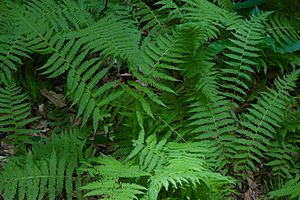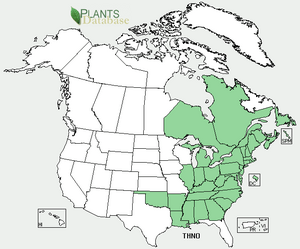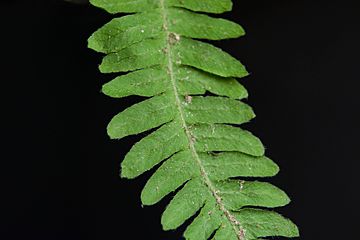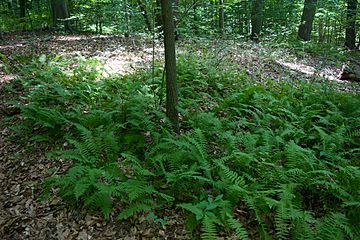New York fern facts for kids
Quick facts for kids New York fern |
|
|---|---|
 |
|
| Conservation status | |
| Scientific classification | |
 |
|
| Range of New York fern via USDA | |
| Synonyms | |
|
The New York fern (scientific name: Parathelypteris noveboracensis) is a type of fern that grows back every year. You can find it across eastern United States and Canada. It grows from Louisiana all the way to Newfoundland.
This fern is most common in the Appalachian Mountains and the Atlantic Northeast region. New York ferns often grow together in large groups. They spread out and form colonies in the forests where they live.
How to Spot a New York Fern
This fern grows in bunches. Each bunch has three or more fronds, which are like fern leaves. These fronds grow from a dark brown, slightly scaly underground stem called a rhizome.
The main stem of the frond is called a stipe. It is about one-fifth the length of the whole leaf. The stipe is brown at the bottom and turns green closer to the leaflets. It usually has brown scales near its base and fine hairs higher up.
The whole fern leaf is typically 8 to 25 inches (20 to 64 cm) long. It's a soft, thin, yellow-green color. A cool thing about this fern is that its leaf gets narrower at both the top and the bottom. The lowest 4 to 10 leaflets are usually smaller than the ones above them.
Each leaf is divided into about 20 smaller parts called pinnae or leaflets. These leaflets are deeply cut into even smaller, rounded parts. The fern makes two kinds of fronds:
- Fertile fronds are bigger and stand up straighter. They produce tiny, round bumps called sori near the edges of the leaflets. These sori hold the fern's spores. A tan, kidney-shaped cover called an indusium protects these sori.
- Sterile fronds do not produce spores.
You can easily tell the New York fern apart because its leaflets get smaller towards the base of the frond. It also forms large groups of ferns that are all connected. These groups are often found on mountain ridges and benches.
Another fern, the ostrich fern, also has leaflets that get smaller at the base. However, ostrich ferns usually grow near rivers and are much taller, up to 5 feet (1.5 meters) tall.
The hay-scented fern also forms big colonies. But unlike the New York fern, the hay-scented fern has a smooth rhizome. Only one frond grows from each spot on its rhizome. Hay-scented fern leaflets also have very jagged edges. New York fern leaflets usually have smooth, rounded edges.
Where the New York Fern Lives
The New York fern is often found in sunny spots in forests. These spots are created when trees fall, making gaps in the tree canopy. You can also see it near wet areas like swamps, wooded ravines, and along streams.
When the soil becomes very acidic (below pH 4.1), this fern can grow very well. It might even take over the area. In these conditions, it can outcompete young tree seedlings. This includes seedlings of the black cherry tree. The fern releases a special chemical that can stop these tree seedlings from growing.
The New York fern is a good sign that an area is a wetland. It is also listed as an endangered species in Illinois.




